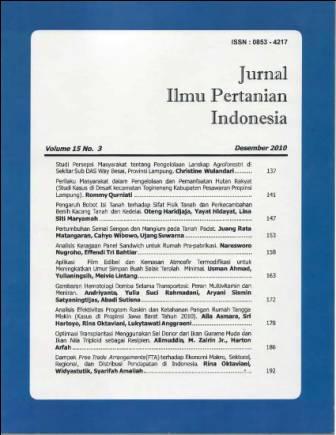Aplikasi film edibel dan kemasan atmosfir termodifikasi untuk meningkatkan umur simpan buah salak terolah minimal
Abstract
Snake fruit is an exotic fruit from Indonesia, and nowadays has increasing in demand. There is opportunity to market minimally processed snake fruit, but this product becomes very highly perishable because of increasing in respiration rate. The objective of this research was to determine edible coating formulation in combination with modified atmosphere packaging, in order to maintain quality and to prolong shelflife of minimally processed snakefruit. The research was started by preparation of salak fruit, edible coating, measurement of respiration rate, determination of optimum atmosphere composition and critical parameter, and storage in modified atmosphere packaging. First, best atmosphere composition for minimally prcessed snakefruit was determined, then storage of minimally processed snakefruit was conducted after selection of the appropriate plastic film. Analysis was conducted on quality and organoleptic characteristics. Optimum gas composition storage for minimally processed snake fruit is 4±1%0[2] and 14±2% C0[2]. Minimally processed snake fruit with edible coatings made from pectin and chitozan combined with modified atmosphere packaging can extend shelflife and maintained quality until eight days, while without edible coating the minimally-processed snake fruit in with modified atmosphere packaging can extend until 6 days only.
Downloads
References
Baldwin, E.A., M.O. Nisperos-Carriedo and R.A. Baker. 1995. Edible coating for lightly processed fruits and vegetables. J. Hort. Sci. 30(1) : 35-37.
Direktorat Jenderal Hortikultura, 2010. www.hortikultura.deptan.go.id. Upaya Pengembangan Kawasan Buah Unggulan Tropika untuk Ekspor.htm [20 Maret 2010]
Gunadnya, I.P.T. 1993. Pengkajian penyimpanan salak segar dalam kemasan film dengan modified atmosphere. [tesis]. Program Pascasarjana IPB, Bogor
Hugh, T dan J. Krochta, 1994. Permeability properties of edible films. Di dalam: Krochta, J., Baldwin, E., Nisperos-Carriedo, M. editor. Edible coatings and films to improve food quality. Technomic Publ. Co., Basel, Switzerland, pp. 139-183.
Lacroix, M. 2009. Mechanical and permeability properties of edible films and coatings for food and pharmaceutical application. Di dalam: Milda E. Embuscado and Kerry C. Huber.editor. Edible films and coatings for food applications. Springer Dordrecht Heidelberg London New York. p.347-335
Olivas, G.I. and Gustavo Barbosa-Cánovas, Edible films and coatings for fruits and vegetables. Didalam: Milda E. Embuscado and Kerry C. Huber, editor. Edible films and coatings for food applications. Springer Dordrecht Heidelberg London New York
Saxena, A., A.S. Bawa, P. S. Raju. 2008. Use of modified atmosphere packaging to extend shelf-life of minimally processed jackfruit. Journal of Food Engineering 87 : 455–466
Setiasih, I.S. 1999. Kajian perubahan mutu salak pondoh dan mangga arumanis terolah minimal berlapis film edibel selama penyimpanan, [tesis]. Program Pascasarjana, Insitut Pertanian Bogor.
Winarno, F.G. 2008. Kimia pangan dan gizi. Edisi terbaru. Mbrio Press.Bogor
Wong, D.W.S., W.M. Camirand, and A. E. Pavlath, 1994. Development of edibel coating for minimally processed fruits and vegetables. Tecnomic Publ. Co. Inc., Lancester.
This journal is published under the terms of the Creative Commons Attribution-NonCommercial 4.0 International License. Authors who publish with this journal agree to the following terms: Authors retain copyright and grant the journal right of first publication with the work simultaneously licensed under a Creative Commons Attribution-NonCommercial 4.0 International License. Attribution — You must give appropriate credit, provide a link to the license, and indicate if changes were made. You may do so in any reasonable manner, but not in any way that suggests the licensor endorses you or your use. NonCommercial — You may not use the material for commercial purposes.



















